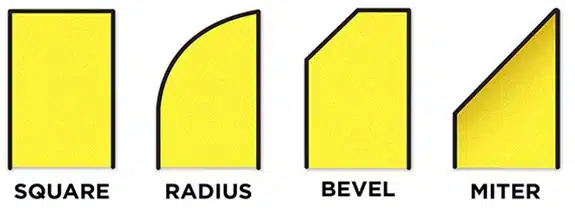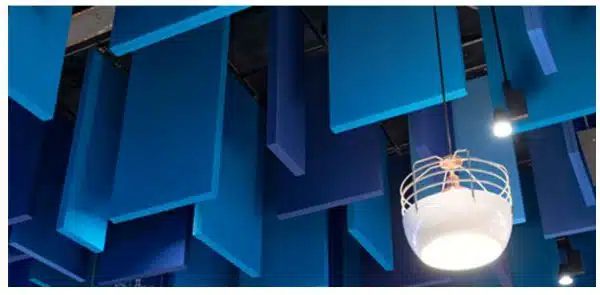Acoustic Ceiling Baffles
Baffle systems are often used to reduce the noise in production areas with high humidity and special hygienic requirements where the application of plane suspended ceilings is problematic. Fabric Sound Baffles can be made using indoor/outdoor decorative fabrics.
Acoustic Ceiling Baffles
Baffle systems are often used to reduce the noise in production areas with high humidity and special hygienic requirements where the application of plane suspended ceilings is problematic. Fabric Sound Baffles can be made using indoor/outdoor decorative fabrics.
Acoustic Ceiling Baffles
Baffle systems are often used to reduce the noise in production areas with high humidity and special hygienic requirements where the application of plane suspended ceilings is problematic. Fabric Sound Baffles can be made using indoor/outdoor decorative fabrics.
Acoustic Ceiling Baffles
Baffle systems are often used to reduce the noise in production areas with high humidity and special hygienic requirements where the application of plane suspended ceilings is problematic. Fabric Sound Baffles can be made using indoor/outdoor decorative fabrics.
Acoustic Ceiling Baffles
 AKINCO acoustic lagging and Wraps are designed to block noise that transmits through the walls of the pipe or as well as to increase the sound absorption in the cavity. Designed to offer significant reduction of radiated noise, it consists of a loaded vinyl noise barrier with a scrim reinforced aluminum foil facing on one side bonded to a 1” sound absorbing decoupler. Our pipe and duct wrap offers excellent thermal and acoustical performance.
AKINCO acoustic lagging and Wraps are designed to block noise that transmits through the walls of the pipe or as well as to increase the sound absorption in the cavity. Designed to offer significant reduction of radiated noise, it consists of a loaded vinyl noise barrier with a scrim reinforced aluminum foil facing on one side bonded to a 1” sound absorbing decoupler. Our pipe and duct wrap offers excellent thermal and acoustical performance.
The sound insulation of soil, waste, sanitary drainage and water pipes shall be from acoustic lagging manufactured with acoustic isolation foam and a mass barrier to a total weight of not less than 5kg/m2.It should be cut to size to neatly fit all pipe work, and incorporate overlaps on all joins. All joins shall be secured with an appropriate foil tape.
Our high-performance composite acoustic pipe lagging product consisting of a reinforced aluminum foil faced, mass loaded flexible vinyl noise barrier bonded to a decoupling layer. The product was developed to reduce noise break-out from pipes, valves, fan housings and ductwork in commercial, industrial and domestic buildings. Ideal for both pipe and duct lagging applications.
The unique construction of lagging gives the dual benefits of a noise barrier and a noise absorber. The highly dense and flexible mass layer provides excellent sound reduction properties, whilst the decoupling layer breaks the vibration path between the substrate and the mass barrier, thus allowing the vinyl external wrap to remain flexible and thereby optimize its performance. The external foil facing offers a fire resistant covering and an excellent surface to join adjacent sheets.
Features
- Allows more space on ceiling for services.
- Enables natural light to come through.
- Allows easy access to services located on ceiling.
- Greater area of absorbing material can be used, particularly for high ceilings.
- Can be easily installed on a T-section suspended ceiling grid or individually suspended.
- Can be used where concrete soffit needs to be exposed for thermal reasons.
- Can be of different colors to suit theme.
- Quickly demountable.
- Height can be easily adjusted.
- Colours can be used to create visually stunning effects.
Technical Information:
- Sizes: Choose from standard sizes or custom sizes up to 4’x8′
- Thickness: 1″ & 2″
- Finish: Camira Cara Fabric
- Density: 96kg/m3 to 120kg/m3
- Edge Detail: Options for Square, Bevel, Radius, Miter Edge details (Natural or Chemically Hardened)
- Fire Rating: Class A
- NRC: 1″ (0.85) 2″ (1.15
Installation
Using Suspension Wires
Clean white gloves must be used when handling to avoid marking the baffles. Install the first baffle and check that the installation is satisfactory before proceeding with the rest of the installation.

Performance
Performance and sound absorption(HZ)
| Thickness | 125 | 250 | 500 | 1000 | 2000 | 4000 | NCR |
|---|---|---|---|---|---|---|---|
| 1″ | 0.14 | 0.27 | 0.80 | 1.11 | 1.14 | 1.14 | 0.85 |
| 2″ | 0.22 | 0.81 | 1.24 | 1.30 | 1.21 | 1.16 | 1.15 |
Edge Details/ Options

If a workplace is near reflecting walls, the recommendation is to use wall absorbers as a complement to the free-hanging units.
Free-hanging units increase the ability to localise sound sources in the vicinity of a workplace. This will increase the sensation of control and create a less stress-induced environment.

When using free-hanging units as a complement to wall-to-wall acoustic ceiling, it is often better to split the free-hanging units into smaller groups and distribute these over the total ceiling area than to use larger free-hanging acoustic baffles irregularly over the ceiling. Division into smaller clusters will enhance the diffraction effect and contribute to a more diffuse sound field.

Baffles are vertically suspended in rows and columns spreading across the expanse of your ceiling as best you can. Our clients provide their own mount method to the ceiling, including wire to thread through our grommets and then the fastening technique to your ceiling, such as J hooks, screws, or twist tied to the top of your joists. The baffles are designed to tuck up inside your runs of joists, with the bottom of the baffle equal or slightly higher than the bottom of the joist. If your ceiling is finished, drywall anchor screws or J hooks work great. If your ceiling is a drop grid tile system, append clips to the grid, thread the wire through the clip and through the grommets to easily support the baffle.
ARCHITECTURAL ACOUSTICS
- Acoustic Underlay
- Acoustic Fabric Panels
- Acoustic ceiling Baffles/ Clouds
- Acoustic Stretch fabric Wall System
- Wooden Acoustic Panels
- Wood wool Acoustic Panels
- Box in Box Constructions/
- Acoustic Walls & Ceiling
- Acoustic Doors
- Acoustic Partitions
- Floating Floors
- Acoustic Ceiling Tiles
- Anti-shock padding
- Base Traps & Sub woofer Isolators
- Acoustic Foam Panels
- Polyester Acoustic Panels
- Aluminum Tubular Ceilings





